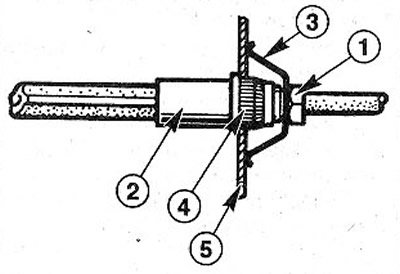As flexible connections between the moving parts of the car, for example, with calipers, brake hoses are designed for a certain pressure.
Removing
1. Place the vehicle on jack stands and align the wheels.
2. Loosen the union nut 1 on the pipeline so that the pressure of the spring 3 is weakened. This causes the toothing 4 of the brake hose 2 to be disengaged (see illustration).

12.2 Loosen the union nut 1 on the pipeline to release the spring pressure
3. Disconnect the brake hose from the wheel cylinder on the caliper. There is no sealing gasket at the connecting joint, because the seal is made by means of a conical connection.
4. Plug the hole in the pipeline with a suitable plug to prevent leakage of brake fluid from the side of the master brake cylinder, or before disconnecting the hose, remove the brake fluid from the expansion tank.
If the wheel cylinder brake hose needs to be changed, the caliper must be removed to replace it.
Installation
5. Install only hoses approved by the RENAULT vehicle manufacturer.
6. Install the caliper.
7. Connect the brake hose, the front wheels should be in a straight position and the front should be raised so that the suspension (wheels) were unloaded. Tightening torque of the hose on the caliper 15 Im.
8. Insert the connecting joint of the hose into the gear lock 5 of the pipeline (see illustration 8.2). Do not kink the hose. Make sure that the limit switch 4 is properly engaged in the gear connection.
9. Install the spring 3 and tighten the union nut with a force of 15 Nm.
10. Make sure the hose follows all wheel movements and does not come into contact with nearby parts. Perform this check with the vehicle raised.
Attention! Keep brake hoses free of oil or fuel, varnish, paint, or underbody protection.
11. Remove air from the brake system.
12. Lower the car on wheels.
Attention! Make sure that
- A) brake hoses are securely connected;
- b) the brake hose is fixed in the holder;
- V) fittings for bleeding the brake actuator are wrapped;
- G) there is enough brake fluid in the expansion tank.
13. Carry out a leak test of the brake system with the engine running.
To do this, depress the brake pedal with a force of 200-300 (20 -30 kg) for approximately 10 seconds. The pressure in the system and, accordingly, on the brake pedal must not drop. Check all connections for tightness.
14. Apply a few brakes on a light road.
